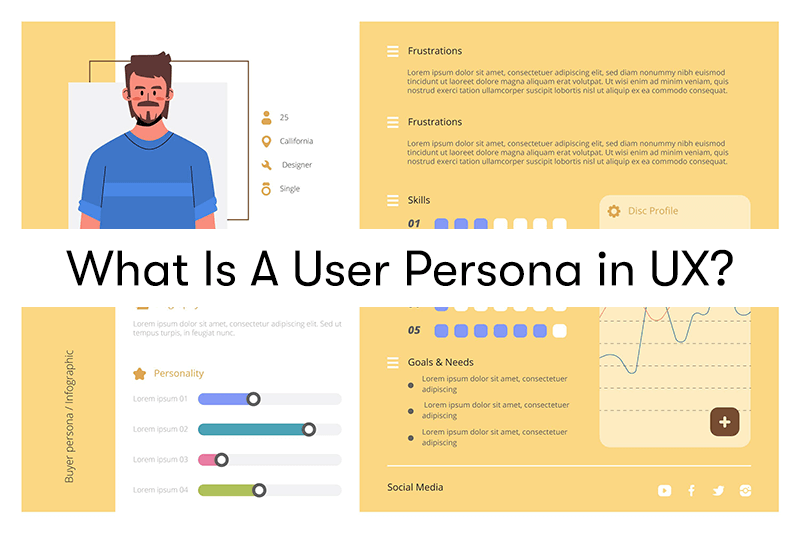What Is A User Persona in UX?
Understanding your audience is paramount in the dynamic landscape of User Experience (UX) design. Enter the user persona, a powerful tool that brings the user to life within the design process. A user persona is a fictional representation of a typical user, meticulously crafted based on real-world data and research. These personas embody your target audience's aspirations, needs, behaviours, and pain points, enabling UX designers to design with precision and empathy. They are a compass, guiding design decisions, prioritising features, and fostering a user-centric approach. In this exploration, we delve into the world of user personas and their pivotal role in shaping exceptional user experiences.
What Are User Personas in UX?
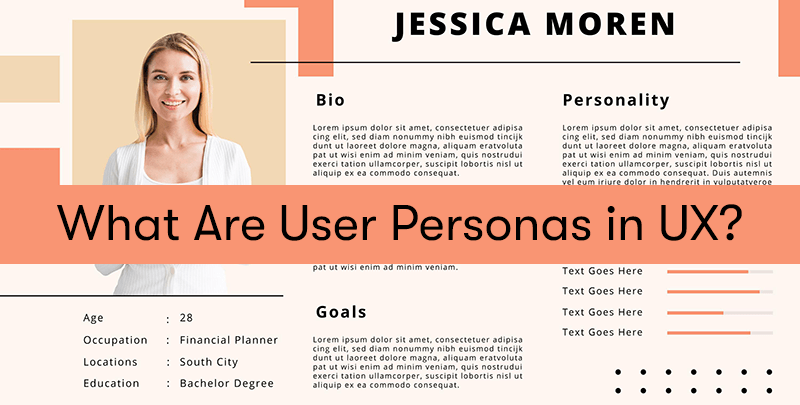
User personas in UX design are fictional representations of typical users or customers of a product or service. They are created to help design teams better understand and empathise with their target audience's needs, goals, behaviours, and preferences. User personas are a crucial tool in human-centred design and can guide the design and decision-making process in various ways.
Personas are given names, images, and sometimes even personal details like age, occupation, and hobbies. This makes them feel more like real people and helps designers relate to them on a personal level.
Each persona includes information about the user's goals, needs, and motivations when interacting with the product or service. This helps designers prioritise features and design elements that cater to these specific requirements.
User personas also describe the typical behaviours and pain points of the users. This can include how they currently solve problems related to the product or what issues they might encounter.
User personas serve as a reference point throughout the design and development process. Designers can ask questions like, "Would Persona A find this feature useful?" or "How would Persona B react to this design choice?"
What Are The Benefits of User Personas in UX?

User personas offer numerous benefits in the field of UX design. Here are some of the key advantages:
User-Centred Design
User personas keep the design process focused on the needs and preferences of the target audience. This leads to products and experiences more likely to resonate with users and provide value.
Empathy and Understanding
Personas help design teams develop a deeper understanding of their users. Team members can empathise with users and make more informed design decisions by creating personas with names, faces, and personal stories.
Consistency
Personas serve as a common reference point for the entire team. They help ensure everyone is on the same page regarding the target audience, reducing the likelihood of conflicting design choices.
Prioritisation
Personas aid in prioritising features and design elements. Designers can focus on the needs and goals of the primary personas and deprioritise less relevant features to the core user base.
Problem Solving
Personas highlight user pain points and challenges, making it easier to identify and address problems in the user experience. This can lead to more effective solutions.
Communication
Personas clearly and concisely communicate user characteristics and requirements to stakeholders, including clients, developers, and marketing teams. They make it easier to convey the who and why of the design.
Reduced Assumptions
Using personas reduces the reliance on assumptions and gut feelings in the design process. Instead, decisions are grounded in accurate data and user insights.
Targeted Marketing and Messaging
Marketers can use personas to tailor their messages and campaigns to specific user segments, improving the effectiveness of marketing efforts.
User Testing
Personas can guide user testing efforts by identifying the key user groups to target during testing. This ensures that user feedback is representative of the actual user base.
Iterative Improvement
Personas are not static; they evolve as more user data becomes available. This promotes an iterative design process where products and services can continuously improve based on user feedback and changing user needs.
Efficiency
Designing with personas in mind can save time and resources by preventing the need for significant redesigns after a product is launched. It helps catch potential issues early in the design phase.
Competitive Advantage
Designing with a user-centric approach can set products and services apart from competitors by providing a superior user experience that meets the target audience's specific needs.
In summary, user personas are a valuable tool in UX design that can lead to more user-centred, efficient, and successful design outcomes. They help ensure that design decisions are based on accurate user data and needs, ultimately leading to better products and experiences.
How To Create A User Persona for UX?
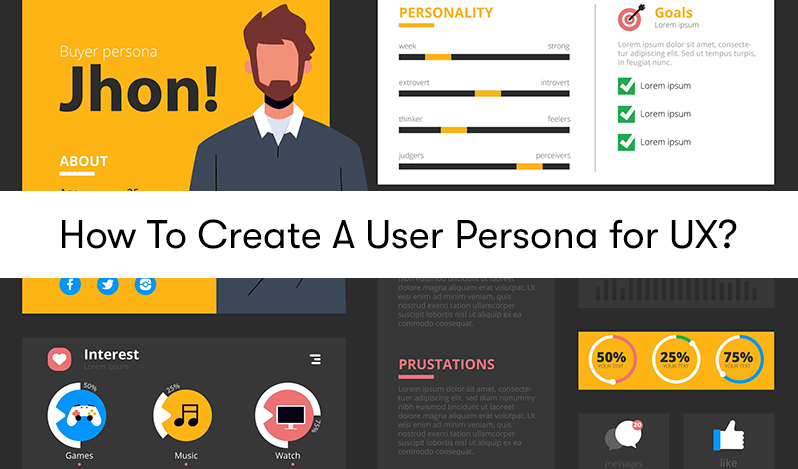
Creating a user persona for UX design involves a structured process that combines research, data analysis, and creative thinking. Here's a step-by-step guide on how to create a user persona:
Define Your Goals
Determine the purpose of creating user personas. What questions or design problems are you trying to address? Understanding your goals will guide your research and persona creation.
Gather User Data
Conduct research to collect information about your target users. Standard research methods include user interviews, surveys, user testing, analytics data, and market research. Gather both qualitative and quantitative data.
Segment Your User Data
Analyse the collected data to identify patterns, commonalities, and differences among your users. Look for demographic information, behaviours, goals, pain points, and motivations that stand out.
Create User Groups or Segments
Group users with similar characteristics and needs into segments. These segments will serve as the basis for your personas. You may have multiple personas, each representing a distinct user segment.
Persona Details
For each user segment, start creating detailed personas. Each persona should include the following elements:
- Name and Photo: Give your persona a name and, if possible, use a stock photo to represent them visually.
- Demographics: Include age, gender, location, occupation, education, and other relevant demographic information.
- Background: Provide a brief background story or description of their personal and professional life.
- Goals: Outline the primary goals and objectives this persona aims to achieve when using your product or service.
- Needs and Pain Points: List the key requirements, challenges, and pain points that this persona encounters concerning your product or service.
- Behaviours and Habits: Describe how this persona typically behaves, their preferred communication channels, and any habits related to your product or industry.
- Motivations: Identify what motivates this persona to use your product or service and how it aligns with their goals.
- Quote or Persona Statement: Include a brief quote or statement that captures the persona's mindset or attitude.
Visual Representation
Create a visual template for your persona profiles. You can use design tools or templates online to structure and format your personas consistently.
Review and Refine
Share the personas with your team and stakeholders for feedback. Make necessary adjustments based on their input and ensure everyone understands and agrees with the personas.
Use Personas in Design
Integrate personas into your design process. Use them as a reference when making design decisions, developing user flows, and prioritising features.
Iterate and Update
User personas should not be static. As you collect more data or as user needs evolve, update and refine your personas to ensure they remain accurate and relevant.
Test and Validate
Conduct usability testing with real users to validate whether your personas accurately represent your target audience's behaviour and preferences. Use the feedback to refine your personas further.
Creating user personas is an ongoing process that should evolve as your understanding of your users deepens. These personas will serve as valuable tools for keeping your design efforts focused on user needs and ensuring that your products or services effectively meet those needs.
What Different Types of User Personas Are Used for UX?
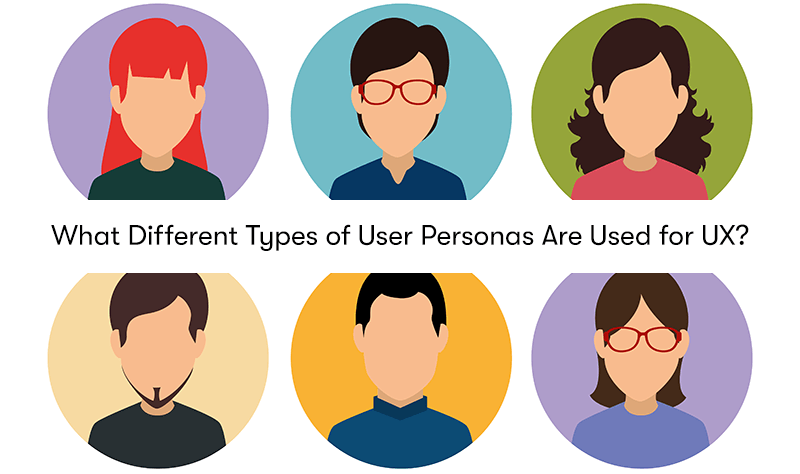
In UX design, different types of user personas can be created to represent various aspects of the target audience. The type of user personas you develop depends on your project's goals and the depth of understanding you need about your users. Here are some common types of user personas used in UX:
Primary Persona
The primary persona represents the core user group that your product or service is primarily designed for. They typically have the most significant impact on design decisions and are the main focus of your UX efforts.
Secondary Persona
Secondary personas are additional user groups that, while not the primary focus, still play a significant role in the user base. Design decisions may consider secondary personas to a lesser extent than primary personas.
Negative Persona
Negative personas represent users who are not part of your target audience. They can help clarify who you are not designing for and prevent feature bloat or design choices that might cater to irrelevant user groups.
Proto-Persona
Proto-personas are preliminary personas created early in the design process when you have limited user data. They are based on assumptions and can serve as a starting point for further research.
Influencer Persona
Influencer personas represent individuals or groups who may not directly use the product or service but have an influence on the decision-making process. For example, in B2B contexts, these could be managers or IT administrators who influence employee software purchases.
Persona Spectrum
Instead of creating distinct personas, you can develop a persona spectrum that captures your users' various traits and characteristics. This approach allows for a more fluid representation of your audience, acknowledging that users may fall along a spectrum of traits rather than neatly into defined personas.
Global Persona
Global personas consider cultural and regional differences in user behaviour and preferences. They are beneficial for products or services with an international or diverse user base.
Task-Based Persona
Task-based personas focus on specific tasks or goals that users want to achieve with your product. They help in designing user flows and experiences for particular use cases.
Behavioural Persona
Behavioural personas are based on user behaviour and usage patterns. They focus on how users interact with your product or service and can help refine user journeys.
Segmented Persona
Segmented personas divide your user base into distinct groups based on specific criteria, such as demographics, behaviour, or psychographics. These personas provide a more detailed view of different user segments.
Customer Journey Persona
Customer journey personas map out the user's journey, from initial awareness to post-purchase experiences. They help in understanding how users interact with your brand at different touchpoints.
Fictional Persona
Fictional personas are entirely made up but based on insights and research. They can be used to explore extreme or hypothetical user scenarios to stimulate creative thinking.
When creating user personas, choosing the types that align with your project's objectives and the level of detail you need to design effectively is essential. In many cases, combining different persona types can provide a comprehensive understanding of your users and their needs.
UX User Personas - Some Examples
E-commerce Website - Primary Persona
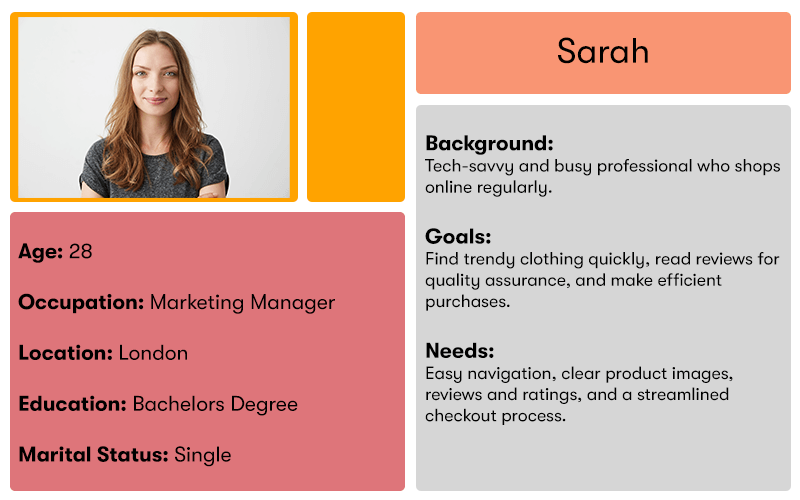
Name: Sarah
Age: 28
Occupation: Marketing Manager
Location: London
Education: Bachelors Degree
Marital Status: Single
Background: Tech-savvy and busy professional who shops online regularly.
Goals: Find trendy clothing quickly, read reviews for quality assurance, and make efficient purchases.
Needs: Easy navigation, clear product images, reviews and ratings, and a streamlined checkout process.
Healthcare App - Secondary Persona
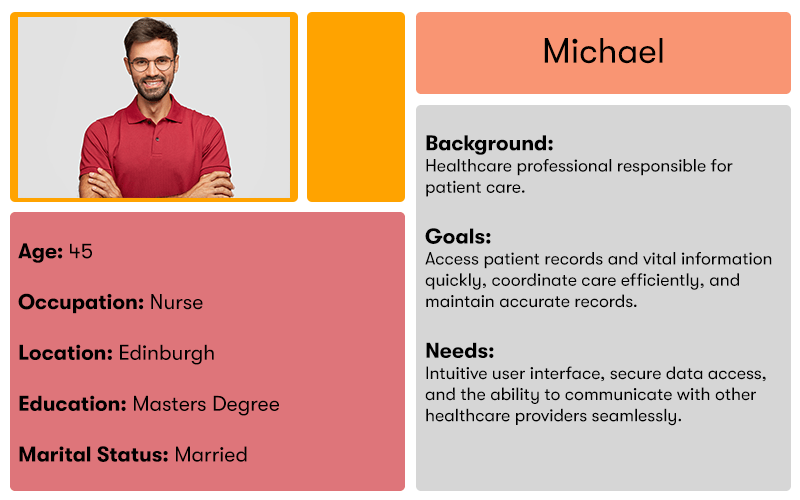
Name: Michael
Age: 45
Occupation: Nurse
Location: Edinburgh
Education: Masters Degree
Marital Status: Married
Background: Healthcare professional responsible for patient care.
Goals: Access patient records and vital information quickly, coordinate care efficiently, and maintain accurate records.
Needs: Intuitive user interface, secure data access, and the ability to communicate with other healthcare providers seamlessly.
Travel Booking App - Negative Persona
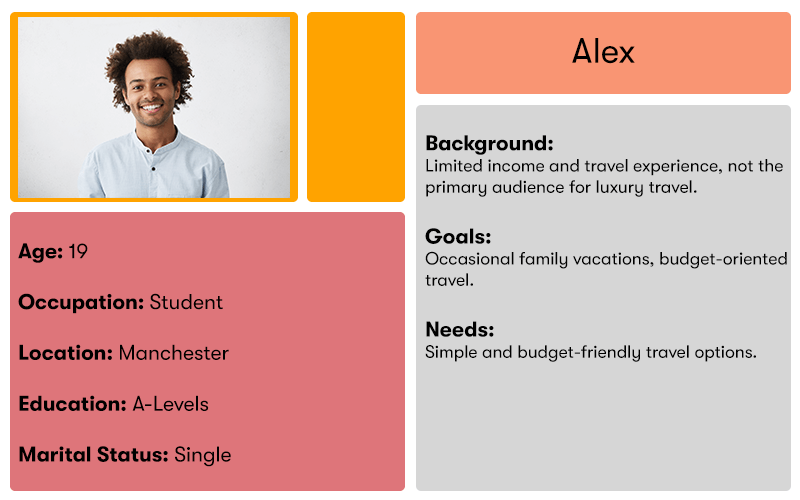
Name: Alex
Age: 19
Occupation: High school student
Location: Manchester
Education: A-Levels
Marital Status: Single
Background: Limited income and travel experience, not the primary audience for luxury travel.
Goals: Occasional family vacations, budget-oriented travel.
Needs: Simple and budget-friendly travel options.
How to Use Personas for Better UX
Using personas effectively is essential for creating a better User Experience. Here are some key ways to leverage personas for improved UX:
Design and Prioritise Features
Align your product or service features with the goals and needs of your personas. Prioritise features that cater to the primary personas and consider the secondary personas to ensure a well-rounded user experience.
User-Centred Design
Keep your personas at the centre of your design process. Continuously ask yourself how a specific design choice or feature aligns with the personas' objectives and whether it helps them achieve their goals.
Create User Flows
Develop user flows and journeys based on the personas' typical behaviours and goals. This ensures the paths users take through your product or website are intuitive and efficient.
Content Tailoring
Customise content, messaging, and calls to action to resonate with different personas. Speak to their specific needs, motivations, and pain points in your messaging and copy.
User Interface (UI) Design
Design the interface with the personas in mind. Consider their preferences for layout, colour schemes, and typography. Ensure that the UI elements are user-friendly for each persona.
Personalisation
Implement personalisation features that adapt the user experience based on the identified personas. For example, recommend products or content that align with a user's persona and past behaviour.
Accessibility
Ensure that your design accommodates users with disabilities, considering the needs of personas who may have different accessibility requirements.
Usability Testing
Use personas as a basis for selecting participants for usability testing. This ensures that your testing pool reflects your target audience, making the feedback more relevant and actionable.
A/B Testing and Iteration
Conduct A/B testing with different designs or features and track how each performs with various personas. Use the data to iterate and improve the user experience continuously.
Cross-Functional Alignment
Share personas with the team, including developers, marketers, and product managers. Ensure everyone has a clear understanding of the target audience and their needs.
Problem Solving
When encountering design challenges or user issues, refer to the personas to guide your problem-solving process. Consider how each persona might be affected by the problem and how it can be resolved to meet their needs.
User Training and Onboarding
Design onboarding experiences that cater to the personas' varying levels of familiarity with your product or service. Provide tutorials, tooltips, or help resources that align with their needs.
Continuous Persona Validation
Regularly update and validate your personas as you gather more user data and insights. Ensure that they remain accurate and relevant to your evolving user base.
Competitive Analysis
Analyse your competitors' offerings with your personas in mind. Identify gaps in the market that align with the unmet needs of your target audience.
User Feedback Integration
Incorporate user feedback and suggestions into your design process, prioritising issues raised by your personas.
By consistently incorporating personas into your UX design process and decision-making, you can create a more user-centred and effective product or service that resonates with your target audience and provides a better overall user experience.
Where Can You Learn More About UX?
Our BCS Foundation Certificate in User Experience training course is perfect for anyone who wants to increase their knowledge of User Experience. The BCS User Experience course will teach you the UX methodology, best practices, techniques, and a strategy for creating a successful user experience. The course will cover the following topics:
- Guiding Principles.
- User Research.
- Illustrating The Context of Use.
- Measuring Usability.
- Information Architecture.
- Interaction Design.
- Visual Design.
- User Interface Prototyping.
- Usability Evaluation.
Click the button below to find out more.

Final Notes On User Personas for UX?
Personas serve as the compass guiding designers through the intricate maze of user needs and preferences. By crafting detailed user personas, teams gain clarity, empathy, and a shared vision of their target audience. These personas drive user-centred design, influencing everything from feature prioritisation and UI elements to content and accessibility.
Personas enable continuous improvement, problem-solving, and personalised experiences when harnessed effectively. They align teams, foster empathy, and ensure every design choice resonates with the end users. In essence, personas are the key to unlocking superior UX.


